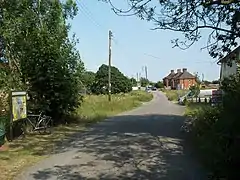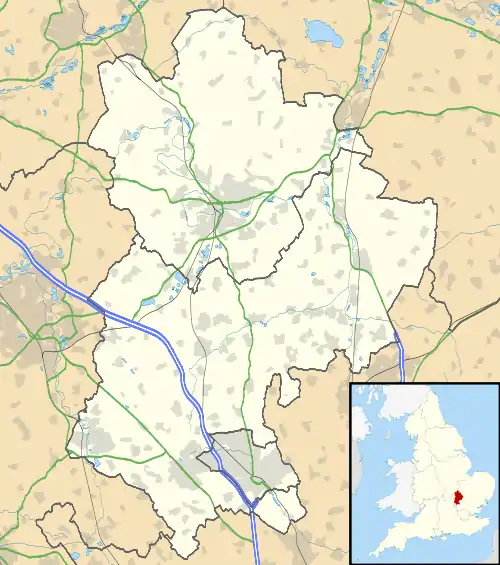Cockayne Hatley
Cockayne Hatley is a small, rural village in the Central Bedfordshire district of the county of Bedfordshire, England 13 miles (21 km) east of the county town of Bedford. The population in 2007 was approximately 75 with 33 houses. It is in the civil parish of Wrestlingworth and Cockayne Hatley.
| Cockayne Hatley | |
|---|---|
 The far end of the village | |
 Cockayne Hatley Location within Bedfordshire | |
| Population | 75 |
| OS grid reference | TL260496 |
| Civil parish | |
| Unitary authority | |
| Ceremonial county | |
| Region | |
| Country | England |
| Sovereign state | United Kingdom |
| Post town | Sandy |
| Postcode district | SG19 |
| Dialling code | 01767 |
| Police | Bedfordshire |
| Fire | Bedfordshire and Luton |
| Ambulance | East of England |
| UK Parliament | |
Geography
Cockayne Hatley lies just over 1 mile (2 km) north of Wrestlingworth, 3 miles (5 km) east of Potton, 6 miles (10 km) north-east of Biggleswade and 13 miles (21 km) south-west of Cambridge.
Landscape
Natural England has designated the area as part of The Bedfordshire and Cambridgeshire Claylands (NCA 88). Central Bedfordshire Council has classified the landscape as Cockayne Hatley Clay Farmland (1C). Characteristics are gentle rolling slopes rising to the low plateau of Cockayne Hatley Wood, from which there are panoramic views to the south-east of large geometric fields bounded by hedgerows.[1]
Elevation
The village centre is 61 metres (200 ft) above sea level. The land rises to 91 metres (299 ft) in Cockayne Hatley Wood.[2]
Geology and soil type
The village lies on boulder clay over gault.[3] The surrounding farmland of 587 hectares belongs to a Danish family and is contract farmed by W.J. Kendall & Sons of Eyeworth, run by Peter Kendall, the former president of the National Farmers' Union, and his brother Richard. The lime-rich loamy and clayey soil is highly fertile but with slightly impeded drainage.[4] The chief crops are wheat, oil seed rape, beans and peas.
History
| Year | Pop. | ±% |
|---|---|---|
| 1801 | 102 | — |
| 1841 | 99 | −2.9% |
| 1881 | 107 | +8.1% |
| 1921 | 87 | −18.7% |
| 1961 | 122 | +40.2% |
| 2001 | n/a | — |
| [5] n/a No separate figure available. Included in Wrestlingworth. Source: Vision of Britain through Time | ||
Cockayne Hatley Hall
Cockayne Hatley Hall, once known as Cockayne Hatley Mansion, was originally established by Sir John Cockayne in the 15th century. The Hall has been added to and rebuilt many times. The main parts of the present building are early Victorian with the East wing dating back to the reign of George I. There is still a single wall and fireplace dating back to Tudor times.
The Cockayne family continued to reside at the Hall until the late 1860s. From 1894 to 1897 the Hall was rented by part of the "Old Family Line", the Duke of Rutland. His daughter, Lady Diana Manners, lived there as a young girl before going on to earn the widespread reputation as the most beautiful young woman in England, and appeared in countless profiles, photographs and articles in newspapers and magazines including the front page of Time magazine in February 1926. In 1929 Mr John Whitehead purchased the estate and established the largest apple orchard in England with over one million Cox's Orange Pippin trees. They were dug up and burned as uneconomic in 1974.[6]
A fire destroyed much of the south facing building in 1931. Although repaired, many of the grand rooms and architecture were lost. Mr Whitehead left the Hall shortly after the war selling the whole estate to the Co-op Farming group. Much of the property subsequently fell into disrepair before the Hall, together with some of the surrounding land, was sold back to private ownership. Now greatly restored, the Hall and the adjacent Church of John the Baptist reflect the affluence of its history.
Crinkle crankle wall
Forming a boundary of the Hall with Home Farm is a grade II listed, late 18th century crinkle crankle wall; the only known example in Bedfordshire. The 2 metres (7 ft) high and 60 metres (197 ft) long angular wall consists of ten zigzags of red brick laid in Flemish bond, with plain brick coping.[7]
Governance
In 1985 the civil parishes of Cockayne Hatley and Wrestlingworth were merged to form Wrestlingworth and Cockayne Hatley Civil Parish. The Parish Council has seven elected members and meets bi-monthly at the Memorial Hall, Wrestlingworth. Cockayne Hatley is part of Potton ward for elections to the Central Bedfordshire Unitary Authority.
Prior to 1894, Cockayne Hatley was administered as part of the Hundred of Biggleswade. From 1894 until 1974 the village was in Biggleswade Rural District and from 1974 to 2009 in Mid Bedfordshire District.
Public transport
No buses serve the village. The nearest railway stations are Biggleswade and Sandy.
St John's Church

The Church of St John the Baptist is situated at the gates of an ancient hall and dates to the thirteenth century. It contains numerous high quality works of carved wood and stained glass, mostly from the abbey of Alne near Charleroi.[8] Dating from 1689, these works were "liberated" from Flanders following the Napoleonic wars[8] by the Rev. Henry Cockayne Cust, parish rector from 1806 to 1861.
The entry for Cockayne Hatley in the 1839 edition of Pigot's Directory Of Bedfordshire states: "the painted windows, the oaken screens and the stalls . . . impart to this incomparable country church the similitude to a cathedral in miniature".
The churchyard contains a handsome monument over the grave of the poet W. E. Henley, who was a frequent visitor to Cockayne Hatley Hall. Henley, who had a wooden leg, was Robert Louis Stevenson's model for Long John Silver. Henley was also a friend of J. M. Barrie, the author of Peter Pan. Henley used to address Barrie as "friend", which Henley's only daughter, Margaret (1888–1894), who is also buried there along with her parents, mispronounced as "fwend" and changed in a childish way to "fwendy-wendy".[9][10] The latter part of this familiar name gave the name of "Wendy Darling" which later became the Wendy of Peter Pan. Henley is now chiefly remembered as the author of the poem "Invictus".
References
- "1C: Cockayne Hatley Clay Farmland" (PDF). Central Bedfordshire. Retrieved 29 September 2019.
- "Wrestlingworth: elevation". Route Calculator. Retrieved 26 August 2019.
- "Sheet 204. Geological Survey of England & Wales". British Geological Survey. Retrieved 26 August 2019.
- "Soilscapes Viewer". LandIS - Land Information System. Cranfield University. Retrieved 26 August 2019.
- "BEDFORDSHIRE POPULATION FIGURES 1801 – 2011" (PDF). Bedfordshire Archives and Records Service Archives. Retrieved 26 August 2019.
- "Cockayne Hatley Crops". Archived from the original on 17 June 2011. Retrieved 7 January 2009.
- Historic England. "A Crinkle Crankle Wall at Home Farm (1138340)". National Heritage List for England. Retrieved 28 October 2019.
- Chisholm, Hugh, ed. (1911). . Encyclopædia Britannica. 3 (11th ed.). Cambridge University Press. p. 622.
- "The History of Wendy". Archived from the original on 18 March 2009. Retrieved 25 July 2009.
- Winn, Christopher. I Never Knew That About England.